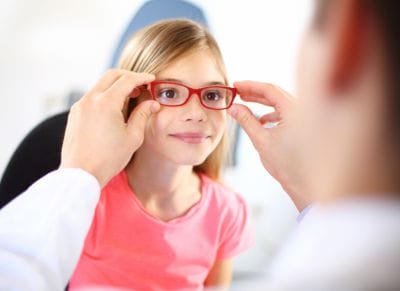Guest Post: Amblyopia (“Lazy Eye”) in Kids: 5 Potential Warning Signs
Coastal Vision is an advertising partner of MyActiveChild.com.

The term “lazy eye” can carry some confusion. Some people use “lazy eye” to refer to the constant turning or wandering of one eye on its own. Within eye care, this is called a strabismus. However, “lazy eye” more accurately refers to an eye that is weak and doesn’t see well–even with glasses. The medical name for this is amblyopia.
Amblyopia results when the eyes are imbalanced in some way. Either one eye doesn’t work well with the other or one eye has a very high vision prescription that developed early in life. In order to avoid visual confusion, the brain learns to ignore the vision coming from the weaker eye. Eventually, the affected eye becomes so weak that it will not initially see 20/20 when it’s finally corrected with glasses. However, picking up early on the potential warning signs of amblyopia will allow for prompt treatment and potential reversal of its effects.
Here are 5 Potential Warning Signs for Amblyopia:
1. Strabismus (eye turn): this is most obvious warning sign for the potential presence or development of amblyopia. Any time a child has an eye that turns in or out while the other is looking straight ahead, it should be evaluated by an eye doctor. If the eye turn is constant, the brain will quickly learn to ignore the image of the turned eye and amblyopia will result. The strabismus may be due to muscle imbalances that can be fixed with glasses and/or eye surgery. It may also be due to the presence of a very high prescription in the affected eye.
2. Closing an eye while reading: this is a clear indication a child is attempting to avoid the effects of unbalanced eyes. Either the affected eye has an alignment issue or it has a very high prescription that is affecting the ability to use the eyes together for reading. Not only will this child demonstrate greatly reduced reading efficiency and comprehension, but amblyopia is a risk.
3. Can’t see 3-D effects: in order to see the “popping out” of objects in 3-D movies, a person must have what is called “stereo vision.” This means the two eyes are well balanced with each other and are able to be stimulated into perceiving depth when using 3-D glasses. However, if a child complains that a 3- D movie looks just as flat as a regular movie, it’s an indication he or she doesn’t have stereo vision. This is most likely due to either a misalignment issue between the two eyes or one eye is extremely blurry compared to the other.
4. Nonverbal children, toddlers, and infants cry when one eye is covered: when a child is nonverbal, it may difficult to detect vision related symptoms. Although nothing takes the place of a complete eye exam, a parent can screen for major issues by presenting the child with an interesting visual target (either television or toys, etc) and alternate covering one eye. If the child consistently fusses, cries, or loses interest when one particular eye is isolated, this is a potential sign of an issue affecting that eye.
5. Double Vision: if a child is developed enough to articulate this symptom, this is a serious warning sign. First, sudden onset of double vision could be an indication of serious medical conditions and needs to be fully evaluated. Second, double vision will eventually lead to the brain ignoring the deficient eyes’ visual input in order to “fix” the double vision.
Even if none of these signs are present, we still believe it is vitally important for children as young as two years to have annual comprehensive eye exams. An eye doctor experienced in pediatric care will curtail the exam process appropriately to the age of the child. With eye and vision problems, early treatment is crucial for successfully treating the condition and reducing its impact on the child over the course of their lives.
Dr. Russ Beach is an optometrist and co-owner of Coastal Vision (www.coastalvisionva.com) with offices in Virginia Beach and Chesapeake. He can be reached at [email protected]





